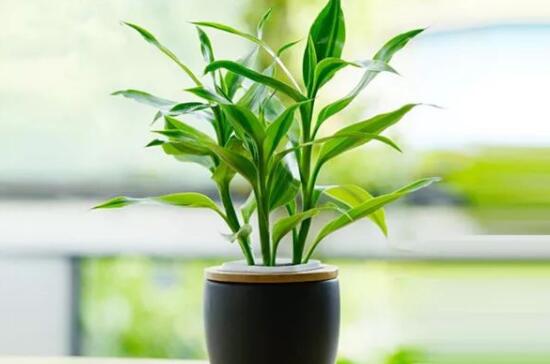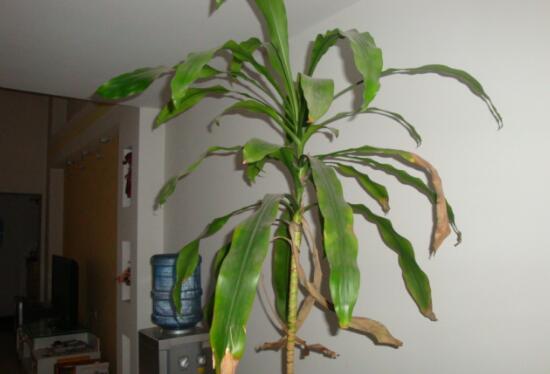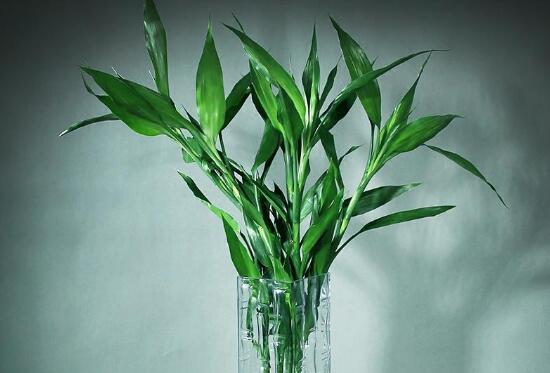How to raise lily bamboo, culture methods and precautions of lily bamboo / avoid bright light
For lily bamboo, flower friends should be no stranger, it is also called Fugui bamboo, is a widely cultivated foliage plant, deeply loved by flower friends. In life, because the efficacy of lily bamboo is strong, so many people want to raise it, then how to raise lily bamboo? The following are carefully arranged by the editor of the lily bamboo culture methods and matters needing attention, very detailed, friends who want to raise must have a look.
First, how to raise lilies and bamboos and understand their habits

Lily bamboo likes high temperature, wet environment, it is drought-resistant, not cold-resistant, like semi-shade, avoid strong light, so how to raise lily bamboo? When breeding indoors, we should put it in an environment with sufficient astigmatism, keep the basin soil moist every day, and take good measures to keep warm in winter. As for the cultivated soil, lily bamboo is not strict with the soil.
II. Culture methods and matters needing attention of Lily Bamboo
1. Soil
How to raise lilies and bamboo indoors? The editor suggested that we should re-choose the potted soil. It is understood that now raising lily bamboo, we all like to buy online, there is existing potted soil, but that soil is very cheap, normal maintenance is OK, but if you want to raise it well, it is best to re-soil.
Soil selection: according to the growth habits of lily bamboo, although it is not strict with the soil, it grows best in the sandy soil which is loose and fertile, well drained and rich in humus. In this regard, the editor recommends that people use rotten leaf soil mixed with river sand or slag ash.
2. Lighting
In the breeding method of lily bamboo, light is very important, but it likes semi-shady environment, so it can be placed under the south window or balcony when family maintenance. The lily bamboo will grow beautifully under sufficient astigmatism.
Note: lily bamboo avoid strong light in summer, but it is best to give lily bamboo some light in other seasons except summer, otherwise the golden stripes in the middle of its leaves will dim and disappear, seriously reducing the ornamental value.
3. Temperature
How to raise lily bamboo? Timely adjustment of temperature is also critical. It is understood that the most suitable growth temperature of lily bamboo is 20-30 ℃. If its leaves are evergreen all the year round, it is best to maintain this temperature when cultured indoors.
Note: Lily bamboo is not cold-resistant, once the temperature is lower than 10 ℃, the plant is vulnerable to frostbite. So in winter, we should move the lily bamboo to indoor culture and keep the overwintering temperature above 10 ℃.
4. Watering
Water is the source of life, so watering is a very important part of the breeding method of lily bamboo. Because the lily bamboo likes a wet environment, and mild drought and wet stains will not damage the plant, so in family maintenance, watering should be carried out alternately, shading can make the branches dense, compact branches and high ornamental value.
5. Fertilization
After watering, let's talk about fertilization, which is also very important in the growth process of lily bamboo. However, lily bamboo does not have high requirements for fertilizer, in addition to adding a certain mature organic fertilizer as base fertilizer when changing pots, organic fertilizer can be applied during the growing period. But the fertilizer should be a small amount for many times, and it is best to water it in time after each fertilization.
6. Pruning
In order to be beautiful, in addition to daily maintenance, timely pruning of lily bamboo is very important. However, the lily bamboo has a certain degree of persistent roots and can grow new branches from the roots, so the plant shape is generally good. Therefore, the pruning of lily bamboo is mainly plastic surgery, cutting off yellow leaves, old leaves, over-dense branches and so on.
7. Replacement of basin soil
Although lily bamboo does not like fertilizer, it is very important to add base fertilizer to the potted soil. But with the increase of breeding time, the nutrients in the potted soil will continue to be lost, so flower friends should change pots for lily bamboo every 2 years in spring. When changing the basin and soil, a certain mature organic fertilizer is added as the base fertilizer to ensure its good growth.
Generally speaking, the lily bamboo is quite easy to raise, but if you want to make it look good, you need to pay more attention and take care of it in accordance with the above requirements, so that it can grow luxuriantly. With regard to the breeding methods and matters needing attention of lily bamboos, this is the end of the editor's introduction. Flower friends who are excited might as well raise them and see.
Culture methods and matters needing attention of Phnom Penh rich bamboo Chinese scientific name Phnom Penh rich bamboo
Latin name Dracaena sanderiana
Also known as longevity bamboo, Xiandalong blood tree
The plant kingdom.
Phylum angiosperm
Monocotyledon class
Subclass lily subclass
Liliformes
Family tequila
Belong to the genus Dragon Blood Tree
Phnom Penh rich bamboo, also known as edge bamboo banana, originated in Congo, Cameroon. Evergreen shrubs, stems slender, erect, basally branched, 1.5 m high, 40 cm wide. The leaves are slightly wavy, curved, lanceolate, 15-25 cm long, with yellow longitudinal bands on both sides of the leaf midrib. Like high temperature, humid and sunny environment, not cold-resistant, resistant to pruning, avoid strong light in summer, loose sandy loam soil is better, winter temperature is not lower than 10 ℃.
1. Morphological characteristics.
The plant is 2 meters high, the stem is erect, the branches are few, and the base of the stem is easy to grow and sprout. Leaves alternate, lanceolate, leaf margin twisted, dark green, glossy.
With yellowish, white or golden edges or vertical stripes, elegant and gorgeous, coupled with chic posture, rich bamboo rhyme.
2. Growth environment
Like high temperature, humid and sunny environment, not cold-resistant, resistant to pruning, avoid strong light in summer, loose sandy loam soil is better, winter temperature is not lower than 10 ℃.
3. Distribution
Native to Cameroon and Congo in West Africa.
4. Cultivation techniques
The method of propagation is commonly used in cutting propagation. The cuttings are best in the rainy season from June to July. Mature branches are selected, cut into 10 cm, and cut into coarse sand. Under the temperature of 25 ℃ and 30 cm, the cuttings take root in 30 days, and can be transplanted into pot in 2 months.
During the growing period, the cultivation method kept the basin soil moist, sprayed water to increase air humidity, fertilized once a semimonthly, changed the pot from April to May every year, and pruned the whole plant in order to germinate new branches. Summer growth is exuberant, should be properly shaded, and frequently watered, do not make the basin soil dry.
5. Disease and pest control
There are common harm of leaf spot, stem rot and root rot, which can be sprayed with 100 times Bordeaux solution for many times. Insect pests are harmful to thrips and scale insects. Spray with 1000 times of omethoate EC.
6. Main value
Phnom Penh rich bamboo plant shape is small, colorful. Suitable for family greening decoration, arranged in windowsill, balcony and desk, can also be embellished in the hall, and used as cut flower ingredients.
7. Daily maintenance
Fertilizer: the demand for fertilizer is not strict, chemical fertilizer or organic fertilizer can be applied during the growing period, but a small amount of chemical fertilizer should be applied for many times and watering in time after fertilization. In addition, when changing the basin and soil every year, a certain mature organic fertilizer can be added as the base fertilizer to ensure its good growth.
Soil: Lily bamboo has good adaptability and can grow in clay and sandy soil, but the sandy soil which is loose and fertile, good drainage and rich in humus can be mixed with plant nutrient soil, rotten leaf soil and river sand. In family cultivation, rotten leaf soil can be mixed with river sand or slag ash. If the basin is changed every 2 years, the foliage plant culture soil can be selected.
Lighting: Lily bamboo likes light, and avoids direct sunlight in summer. Family maintenance can place it under the south window or balcony, only to avoid direct light in summer, and it is best to give certain light in other seasons. otherwise, the golden stripes in the middle of the leaves will be dim and disappear, seriously reducing the ornamental value.
Humidity: the optimum growth temperature is between 20 and 30 ℃, the overwintering temperature is better kept above 10 ℃, and it is not resistant to low temperature freezing injury. A certain amount of air humidity is needed in the process of growth, otherwise the color of the leaves becomes dim and the glossiness decreases. Water can be frequently sprayed to the plant during the growing period, and if conditions permit, it is best to increase moisture and humidity in the environment.
Introduction to the Culture methods of Fugui Bamboo in Phnom Penh
Phnom Penh rich bamboo is also the best ornamental product of potted plants, like high temperature, humid and sunny environment, but it is not cold-resistant but resistant to pruning, it is taboo to direct light on it in summer, the soil should also be loose sandy soil as the best, the temperature in winter is not lower than 10.
* Phnom Penh rich bamboo growing environment Phnom Penh rich bamboo it likes wet and hot and sunny environment, and it is not cold-resistant but very resistant to pruning, in summer is to avoid the direct light on it, the soil should also be loose sandy soil for the best, the temperature in winter can not be lower than 10 degrees.
* the culture method of rich bamboo in Phnom Penh is often carried out by cutting propagation, which is best in the plum rain season from June to July, selecting mature branches and cutting them into 10 cm in coarse sand, under the condition of 25-30 degrees. It will begin to take root in 20-30 days, and it can be transplanted to the pot in 2 months. Keep the basin soil moist at any time during its growth, spray water to increase the humidity in the air, fertilize it once every half a month, and change the basin for it every April-May, and prune the whole plant in order to sprout new branches. it belongs to its peak growing season in summer, shading properly and watering frequently, so that the basin soil can not be too dry.
The optimum growth temperature is between 20 and 30 ℃, the overwintering temperature is better kept above 10 ℃, and it is not resistant to low temperature freezing injury. A certain amount of air humidity is needed in the process of growth, otherwise the color of the leaves becomes dim and the glossiness decreases. Water can be frequently sprayed to the plant during the growing period, and if conditions permit, it is best to increase moisture and humidity in the environment. Lily bamboo has good adaptability and can grow in clay and sandy soil, but the sandy soil which is loose and fertile, good drainage and rich in humus can be mixed with plant nutrient soil, rotten leaf soil and river sand. In family cultivation, rotten leaf soil can be mixed with river sand or slag ash. If the basin is changed every 2 years, the foliage plant culture soil can be selected.
* the main value of Phnom Penh rich bamboo because its plant type is small, and the color is also gorgeous, so it is very suitable for greening decoration in the family, it is arranged on the windowsill, balcony and desk, it can also be placed in the hall for decoration, and finally can be used as an ingredient for cut flowers.
- Prev

How to trim the Brazilian iron tree, the pruning method of the Brazilian iron tree / cut the root if it grows too high
Brazilian iron tree, also known as Brazilian wood, its plant type, broad and shiny leaves, is currently the most popular foliage plant. In life, there are many people who raise Brazilian iron trees, but they may not make them look good, but most of them are not pruned properly, so how to prune them?
- Next

How to prune lily bamboo, the pruning method of lily bamboo diagram / pruning the overdense branches of old leaves and yellow leaves
Lily bamboo is no stranger to everyone, it is the most common foliage plant in the family, its plant type is beautiful, the leaves are elegant and elegant, and the leaves are evergreen all the year round. However, if you want lily bamboo to look beautiful, in addition to daily maintenance, timely pruning is also very important. So, how to trim the lily bamboo?
Related
- Fuxing push coffee new agricultural production and marketing class: lack of small-scale processing plants
- Jujube rice field leisure farm deep ploughing Yilan for five years to create a space for organic food and play
- Nongyu Farm-A trial of organic papaya for brave women with advanced technology
- Four points for attention in the prevention and control of diseases and insect pests of edible fungi
- How to add nutrient solution to Edible Fungi
- Is there any good way to control edible fungus mites?
- Open Inoculation Technology of Edible Fungi
- Is there any clever way to use fertilizer for edible fungus in winter?
- What agents are used to kill the pathogens of edible fungi in the mushroom shed?
- Rapid drying of Edible Fungi

